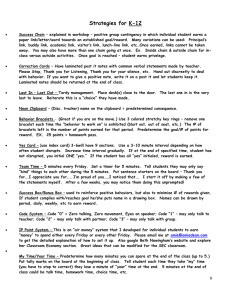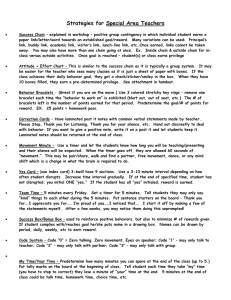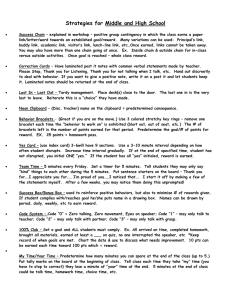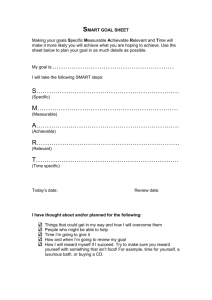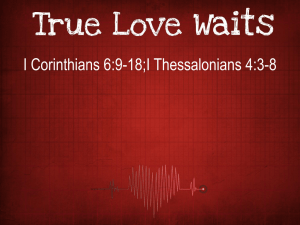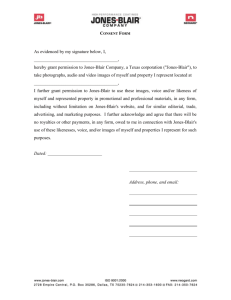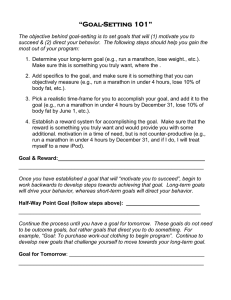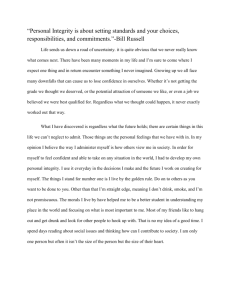CLASSROOM DISCIPLINE CYCLE (CDC)
advertisement
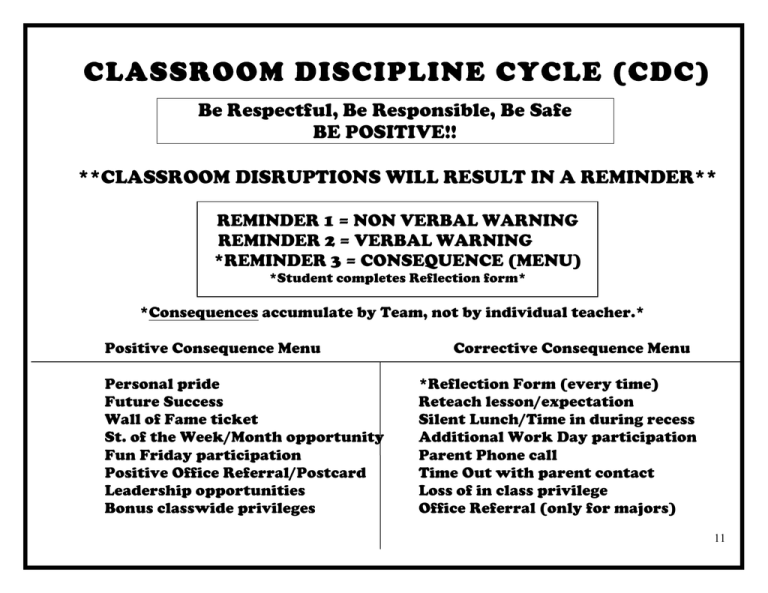
CLASSROOM DISCIPLINE CYCLE (CDC) Be Respectful, Be Responsible, Be Safe BE POSITIVE!! **CLASSROOM DISRUPTIONS WILL RESULT IN A REMINDER** REMINDER 1 = NON VERBAL WARNING REMINDER 2 = VERBAL WARNING *REMINDER 3 = CONSEQUENCE (MENU) *Student completes Reflection form* *Consequences accumulate by Team, not by individual teacher.* Positive Consequence Menu Personal pride Future Success Wall of Fame ticket St. of the Week/Month opportunity Fun Friday participation Positive Office Referral/Postcard Leadership opportunities Bonus classwide privileges Corrective Consequence Menu *Reflection Form (every time) Reteach lesson/expectation Silent Lunch/Time in during recess Additional Work Day participation Parent Phone call Time Out with parent contact Loss of in class privilege Office Referral (only for majors) 11 The Pyramid of Posi:ve Behavior There are 5 components. Let’s explore strategies for each component. REFERRAL -­‐-­‐-­‐-­‐-­‐-­‐-­‐-­‐-­‐-­‐-­‐-­‐-­‐-­‐-­‐-­‐-­‐-­‐-­‐-­‐-­‐-­‐ Tier Three 5-­‐10% Students SMALL GROUP RESOLUTION -­‐-­‐-­‐-­‐-­‐-­‐-­‐-­‐-­‐-­‐-­‐-­‐-­‐-­‐-­‐-­‐-­‐-­‐-­‐-­‐-­‐-­‐-­‐-­‐-­‐-­‐-­‐-­‐-­‐-­‐-­‐-­‐-­‐-­‐-­‐-­‐-­‐-­‐-­‐-­‐-­‐-­‐-­‐-­‐-­‐ INTERVENTION/ REFLECTION Tier Two 10-­‐20% Students -­‐-­‐-­‐-­‐-­‐-­‐-­‐-­‐-­‐-­‐-­‐-­‐-­‐-­‐-­‐-­‐-­‐-­‐-­‐-­‐-­‐-­‐-­‐-­‐-­‐-­‐-­‐-­‐-­‐-­‐-­‐-­‐-­‐-­‐-­‐-­‐-­‐-­‐-­‐-­‐-­‐-­‐-­‐-­‐-­‐-­‐-­‐-­‐-­‐-­‐-­‐-­‐-­‐-­‐-­‐-­‐-­‐-­‐-­‐-­‐-­‐-­‐-­‐-­‐-­‐-­‐-­‐-­‐-­‐-­‐-­‐-­‐-­‐-­‐-­‐-­‐-­‐-­‐-­‐-­‐ POSITIVE INSTRUCTION PREVENTION Tier One 80-­‐90% Students 12 Apology Slip Name:________________________________Date_____________Name of person harmed:___________________ This is what I did: _____________________________________________________________________________________________ _____________________________________________________________________________________________ _____________________________________________________________________________________________. What I should have done was: _____________________________________________________________________________________________ _____________________________________________________________________________________________ _____________________________________________________________________________________________. When I harmed___________________________, I think he/she felt ______________________________________ _____________________________________________________________________________________________. I would like to say:_____________________________________________________________________________. Signed:________________________________________ Signed:________________________________________ (student completing the form) (teacher and/or parent) Better Choices Sheet Name:______________________________________Date:_____________________Time:___________ My actions were as follows: (What I did) ____________________________________________________________________________________ ____________________________________________________________________________________ ___________________________________________________________________________________. A better choice, which I will do next time is: ____________________________________________________________________________________ ____________________________________________________________________________________ ___________________________________________________________________________________. Why I made the bad choice: ____________________________________________________________________________________ ___________________________________________________________________________________. To help myself, the next time something like this happens, I will _________________________________ ___________________________________________________________________________________. Student Signature:_______________________________Teacher/Adult___________________________ M U L T IP L E IN T E L L IG E N C E S P R O FIL E Rank each set of activities from a number of 1 to 8 where 1 is the lowest in time preference or talent and 8 is the highest. (Each group should have a 1, 2, 3, 4, 5, 6, 7, & an 8.) I spend the most time: ____Participating in outdoor activities (h) ____Drawing or painting (b) ____Playing an instrument (f ) ____Being with others (d) ____Writing poems, stories, or letters (a) ____Working with computers or doing science projects (c) ____Doing things by myself (e) ____Exercising or playing sports (g) I prefer to: ____Take objects apart and figure out how they work (c) ____Exercise, ride a bike, or be active with my body (g) ____Look at comics, art, or movies (b) ____Observe rocks, plants, or animals (h) ____Join clubs and social activities (d) ____Listen to music (f) ____Read a book (a) ____Think about myself, my life, and how I handle situations (e) I am good at: ____Recognizing, remembering, humming, or singing tunes (f) ____Understanding people, knowing and appreciating people (d) ____Talking, writing, or playing with language and words (a) ____Looking at things, drawing, using maps (b) ____Using my hands or body to make or do things (g) ____Identifying patterns in my environment (h) ____Constructing things, pulling them apart, or asking “why” (c) ____Being myself, doing things at my own initiative and pace (e) I learn best by: ____Talking to others (d) ____Tuning into rhythm, turning things into a song (f) ____Seeing or making a picture, map, or diagram of an idea (b) ____Practicing, moving around a lot, and doing things (g) ____Taking time to understand things by myself (e) ____Listening, reading and writing, or speaking to myself (a) ____Analyzing, explaining, and understanding why (c) ____Using my senses to make connections in the world around me (h) Profile: To score, add up the totals for each letter and place them next to the intelligence it represents. The highest number indicates the intelligence in which you have the greatest interest, time, energy, or skill. The lowest indicates the intelligence in which you have the least interest, time, energy, or skill. a. Verbal/Linguistic_____ b. Visual/Spatial_____ c. Logical/Mathematical _____ d. Interpersonal _____ e. f. g. h. Intrapersonal _____ Musical _____ Bodily/Kinesthetic _____ Naturalist _____ Student Growth Chart Name:_____________________________Class:______________ Activity Pre-Test Post-Test Difference +/- ATTITUDE + EFFORT = REWARDS Cycle 1 What is our reward?_________________________________________________________________ Cycle 2 What is our reward?_________________________________________________________________ Cycle 3 What is our reward?_________________________________________________________________ Name: Where are you NOW? Action Plan ________________________________________________________________________ 1 Focus On Negative 5 10 Occasionally Positive Positive 15 Very Positive 20 Extremely Positive 1. Please think about the comments you make to your teachers. Let’s quantify this way: Ask yourself approximately how many positive contacts (verbal, written, or electronic) do I have with my teachers in a 5 day period? #___________ If you are not sure where to place yourself on the continuum, use the following as a guideline only: 20+ is extremely positive in 5 days, 10-14 very, 5-9 positive, 2-4 occasionally, 0-1 may focus on negative 2. What are some of the typical things you say to praise or compliment your staff and individual teachers? Please list below. 3. Do you have room for improvement? If so, please write a goal for how many positive comments you would like to make in daily or half day increments. (Ex. I will go from making 3 positive contacts per week to 10 positive contacts per week.) MY GOAL:___________________________________________________________________ _____________________________________________________________________________. STEPS I will take to achieve this goal: Positivity Action Plan 2007 Amie Dean Strategies for Secondary • Success Chain – explained in workshop – positive group contingency in which the class earns a paper link/letter/word towards an established goal/reward. Many variations can be used: Principal’s link, buddy link, academic link, visitor’s link, lunch-line link, etc…Once earned, links cannot be taken away. You may also have more than one chain going at once. Ex. Inside chain & outside chain for in-class versus outside activities. Once goal is reached – whole class reward. • Correction Cards – Have laminated post it notes with common verbal statements made by teacher. Please Stop, Thank you for Listening, Thank you for not talking when I talk, etc. Hand out discreetly to deal with behavior. If you want to give a positive note, write it on a post it and let students keep it. Laminated notes should be returned at the end of class. • Last In – Last Out – Tardy management. Place desk(s) close to the door. The last one in is the very last to leave. Reiterate this is a “choice” they have made. • Neon Clipboard – (Disc. tracker) name on the clipboard = predetermined consequence. • Behavior Bracelets - (Great if you are on the move.) Use 3 colored stretchy key rings – remove one bracelet each time the “behavior to work on” is exhibited (blurt out, out of seat, etc.) The # of bracelets left is the number of points earned for that period. Predetermine the goal/# of points for reward. EX. 25 points = homework pass. • Yes Card – (use index card) 3-6will have 9 sections. Use a 3-10 minute interval depending on how often student disrupts. Increase time interval gradually. If at the end of specified time, student has not disrupted, you initial ONE “yes.” If the student has all “yes” initialed, reward is earned. • Team Time – 5 minutes every Friday. Set a timer for 5 minutes. Tell students they may only say “kind” things to each other during the 5 minutes. Put sentence starters on the board – Thank you for….I appreciate you for…… I’m proud of you……I noticed that…. I start it off by making a few of the statements myself. After a few weeks, you may notice them doing this unprompted! • Success Box/Bonus Box – used to reinforce positive behaviors, but also to minimize # of rewards given. If student complies with/reaches goal he/she puts name in a drawing box. Names can be drawn by period, daily, weekly, etc to earn reward. • Code System – Code “0” = Zero talking, Zero movement, Eyes on speaker; Code “1” – may only talk to teacher; Code “2” – may only talk with partner; Code “3” – may only talk with group. • 100% Club – Set a goal and ALL students must comply. Ex. All arrived on time, completed homework, brought all materials, earned at least a ___ on quiz, no one interrupted the speaker, etc *Keep record of when goals are met. Chart the data & use to discuss what needs improvement. 10 pts can be earned each time toward 100 pts which = reward. • My Time/Your Time – Predetermine how many minutes you can spare at the end of the class (up to 5.) Put tally marks on the board at the beginning of class. Tell class each time they take “my” time (you have to stop to correct) they lose a minute of “your” time at the end. 5 minutes at the end of class could be talk time, homework time, choice time, etc. 19 RESOURCES WEBSITES: • www.behaviordoctor.org – my favorite website for discipline ideas for EVERYONE and working with at risk or special need students. Many free books under the “Booklets” tab on the right. • www.newmanagement.com – download the ClipChart e-book for free! LOVE IT! • www.wholebrainteaching.com – amazing management techniques – check Chris Biffle out on youtube to see exactly how to do it! I watched an 8 min video & had 5 strategies down pat. • www.classdojo.com – FREE software for tracking student behavior – clean, simple, runs reports! • http://hill.troy.k12.mi.us/staff/bnewingham/myweb3/ - Beth Newingham’s site on a Classroom Economy with free downloads, pictures, and video • www.skillstreaming.com – Packaged social skills program for 3 different age groups – simple to use, inexpensive, and research-based. I used it & loved it. • www.jigsaw.org – explains Jigsaw method • www.teach-nology.com (rubric maker & tons of free rubrics!) • www.kaganonline.com (Teachtimer, Hallway Pass, and Team Timers) • www.eduplace.com and www.readingquest.org– free graphic organizers • www.Internet4classrooms.com – AMAZING – lots of activities for every standard you can imagine • www.interventioncentral.org – many academic and behavioral strategies • www.PatQuinnResources.com – more resources for RTI than you could ever dream of! • www.terryalderman.com – great books that explain several of today’s strategies plus many more! • http://www.igs.net/~cmorris/inventories_on_mi.html list of online multiple intelligence inventories BOOKS: • A Framework for Understanding Poverty by Ruby Payne • Teaching with Love and Logic by Jim Fay • The First Days of School by Harry K. Wong • Do You Know Enough About Me to Teach Me? A Student’s Perspective by Stephen Peters • Rational Discipline • Partners in Learning: from Conflict to Collaboration in Secondary Classrooms, by Carol Miller Lieber by Terry Alderman 20
